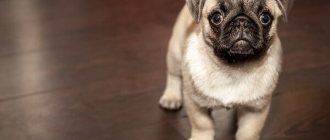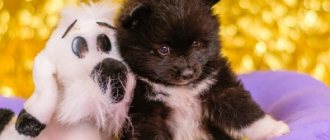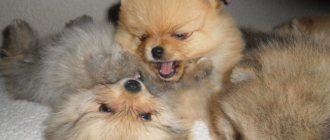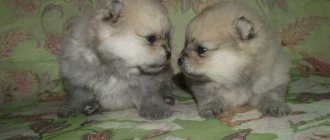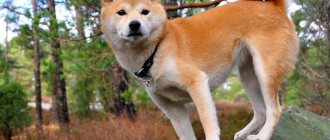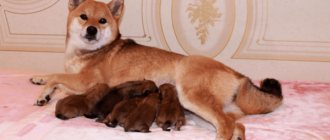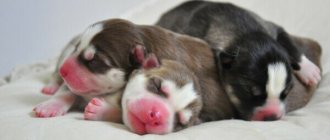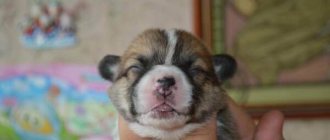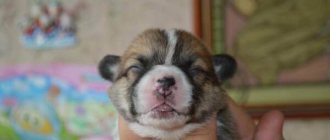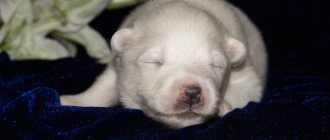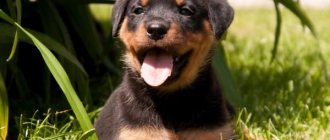Pug dogs are square, stocky dogs with a short muzzle.
Mentions of these animals are described in ancient Chinese manuscripts. The pug breed, like the Pekingese, undoubtedly comes from China, although they are also mentioned in the ancient Hindus.
These dogs were the favorites of the emperors of that era.
Their only purpose was to accompany the emperor. It is known that pugs had personal servants who carried them on special stretchers.
Since the establishment of trade routes between Europe and the Far East, about 400 years ago, pugs have gained popularity in Europe among both nobility and commoners.
There is a story about how a pug saved William of Orange by waking him up when the Dutch king’s camp was attacked by an enemy, and since then he has become the official dog of the House of Orange.
The pug was a favorite of Queen Victoria and Empress Josephine, wife of Napoleon.
Origin story
The breed is distinguished by the fact that in appearance their face resembles that of a monkey, with large, dark, wide-set eyes. For this reason, in England, pug dogs are called “Pug”, this is due to the humorous nickname of the cheerful monkeys.
The pug has been a ladies' dog since the 17th century, their charming ugliness complementing the beauty and sophistication of their owner..
Disadvantages of the breed
Even such an angelic character has its pitfalls. One of the most pronounced ones is stubbornness . Sometimes it is stronger than that of a donkey.
When something happens against their will, they show stubbornness until the person makes concessions to them. You will reach an agreement with your four-legged friend exclusively in a peaceful way. It is useless to break his nature.
They are also terrible beggars and gluttons rolled into one. At such moments it is difficult not to indulge them.
They are also too jealous, which pushes them to all sorts of meanness. The reason for this is the desire to always be in the center of attention, without recognizing the right of your patron to his personal life.
a brief description of
Pugs are funny, inquisitive, friendly, self-loving, and the sounds made by these cuties (grunting, snoring, snorting) attract everyone's attention.
They are devoid of aggressiveness and are very attached to their owner.
Pugs are excellent companions; they are ready to participate in everything their owner does; they are able to get rid of a bad mood, as they are cheerful and good-natured..
The breed standards adopted in our time prescribe several types of heads for pugs: a convex rectangular skull, with a wide part of the muzzle and a normal shape.
The body is “square format”; the length of the body is equal to the height at the withers. The dog should look harmonious, all parts of its body are proportional.
Read more detailed characteristics of the breed here.
Photos and videos on the topic
It is useful for future pug owners to learn more information about representatives of the breed. This is facilitated by watching video materials that describe in detail the conditions of detention, features of care and feeding of dogs. Photos of representatives of the breed of different colors will help you determine your preferences and choose the most suitable option.
Pug puppies are unpretentious and good-natured dogs. They will become excellent friends for calm owners. Patience, consistency and boundless love will help raise a healthy, developed dog who will delight the family for many years.
What do newborns look like?
Pugs are born completely blind, wet and helpless. It is necessary that puppies immediately begin to suck colostrum - in the first half hour.
IMPORTANT!
As soon as the baby is born and begins to open its mouth, immediately connect it to the mother's nipple.
Newborn babies - quite active two or three days from birth - crawl, shaking their heads from side to side, trying to maintain balance.
They quickly freeze and, therefore, having just lost their mother, they begin to squeak, crawl in circles, and scream. As soon as the puppy finds its mother, it attaches itself to the nipple, begins to push it with its front paws, sucks milk, its tail rises perpendicularly upward.
Such pictures are simply touching.
Puppies are unusually voracious.
In the first month of life, puppies receive most of their care from their mother; she licks them, which helps them feel that she is nearby and everything is okay . In addition, this is a kind of massage that promotes urination and defecation.
Advantages of the breed
The most important of them is courage . Even large individuals will not stop the faithful guard. They never come into conflict until there is a real threat.
The tiny creature is always ready to defend its space and the people dear to it. In this case, the size of the enemy does not play a role.
Other advantages include the following:
- love;
- patience with small children;
- the ability to coexist peacefully with others;
- allow themselves to be caressed;
- high intelligence;
- compact dimensions;
- ease of learning.
At the same time, they are not inclined to try to establish dominance over their owner, because they are very attached to him.
How it develops from 1 to 12 months
Newborn puppies sleep up to 22 hours a day, closer to 2 months they sleep 18 hours.
At 1 month, the puppy weighs from 0.7 to 1 kg. At eight weeks, puppies weigh between 900 g and 1.8 kg.
From 3-4 months, pug pups begin to erupt permanent teeth. Their weight is from 1.5 to 2.2 kg.
At 4-6 months, young dogs begin puberty. During this period, pugs weigh from 3.17 to 7 kg.
At 9 months, growth slows down, and in some puppies it even stops. Weight between 6 and 9 kg.
1 year is the time for a pug to become an adult..
Their weight ranges from 6.5 to 9 kg. Height is from 26 to 28 cm at the withers for females, 29-31 cm for males.
Weight reaches its maximum value, excess weight gain is a signal for the owner, as this becomes a problem of obesity for the dog.
Application
Pugs are the ideal example of a pet.
The breed is suitable for older people who want to have a loyal, intelligent and not fussy four-star friend.
Pug dogs, like Maltese dogs , get along well with children, but are more likely to refuse noisy games, preferring to watch them on the sofa.
In some countries, the breed is used as a service dog.
Possessing a keen sense of smell, pugs are excellent at finding drugs.
An active, cheerful pug loves to frolic in the fresh air.
Types of puppies
Pug puppies are divided into three types:
- Show class - show pugs they meet accepted standards. This is the most expensive type. The owner will need patience, these pets require a lot of investment and time from the owner. They are beige and black in color.
- Breed class is a breed for breeding. Elite, producing strong and healthy offspring.
- Pet class - this species has a slight defect. These are incorrectly positioned ears, non-standard color. Nevertheless, these dogs can become faithful four-legged friends. They are cheaper, but no less cute.
There are also mini pugs or dwarf ones. They are short in stature with short legs.
Officially this species does not exist, this type has a genetic disorder . But nevertheless, he is popular due to his toy-like appearance.
This subspecies is crossed with other breeds: Chinese Crested, French Bulldog, Dachshund, etc.
Read about what other types of pugs there are here.
Price
The cost of puppies depends on the region of purchase, age, color and pedigree. The price of dogs of ordinary colors (red, beige, silver) is 10,000-12,000 rubles, and small black pugs cost from 15 thousand to 20 thousand.
Pet-class puppies without a famous family are purchased for 10,000-15,000 rubles. The presence of a pedigree, documents, and the dog’s compliance with all standards increases this figure to 20,000-60,000 rubles.
Most nurseries have websites where they post photos of animals, supplemented with all the necessary information about them. Buying a pug online reduces the price to 8,000-9,000 rubles.
How to care?
Caring for a puppy takes some time.
It is especially necessary to pay attention to claws, fur, ears, eyes and skin folds. Train your pet to relieve itself in a designated area .
Trim your nails once every two weeks. The ears need to be tied up, the eyes should be wiped of mucus, and if necessary, use drops after consulting with a veterinarian.
Pugs are strictly forbidden to walk in tall grass and where it is very dusty . You need to walk your dog at least 2 times a day.
Folds need to be wiped regularly, you can use wet wipes. Be sure to protect them from hypothermia and overheating.
It is not advisable to bathe babies, but you can use a washcloth with wool products. From two months you can start water procedures.
After a walk, thoroughly wipe your paws, nose and tummy, wiping them dry with a clean towel..
Due to their narrow airways, dogs do not tolerate heat or cold well. This also causes problems with the cardiovascular system.
To warn them, you need to walk the dog for about half an hour, and make sure that he does not gain extra pounds.
Pugs are stubborn and need to be trained patiently ; they can be taught commands such as “fu”, “sit”, “lie down” and “next” .
They get accustomed to the toilet, their place.
What diseases can they suffer from?
A disease or pathology in a newborn dog can occur due to improper care or birth trauma. The most commonly observed deviations are:
- bloating;
- diarrhea;
- constipation;
- breathing problems;
- spasms.
Abdominal bloating occurs due to the fact that during the sucking process the animal takes in a large amount of air. At the beginning of complementary feeding, such a deviation may indicate overeating or the development of a fermentation process in the animal’s gastrointestinal tract.
Gases accumulate in the intestines. Over time, they cause pain and interfere with the normal functioning of the digestive system. To alleviate the animal’s condition, the following actions are performed:
- Give a gentle abdominal massage. The puppy should be placed on your left hand with its belly up, while using the fingers of your right hand to perform light massaging movements.
- Insert the thin rubber tip of the pipette into the anus. This procedure will help remove gases.
To avoid a negative reaction, you should try not to overfeed your dog and give it only high-quality and fresh food.
Sometimes regurgitation of a small part of the food is observed. This is due to overeating and swallowing air. If your puppy spits up after every meal, then he should be seen by a doctor.
Diarrhea can occur for various reasons. Most often it is provoked by a violation of the intestinal microflora.
For constipation, it is recommended to change the mother's diet if the dog only accepts her milk. In this case, it is recommended that an adult dog add vegetable oil to its food. If the puppy eats other food, a small amount of fiber should be introduced into its diet.
Difficulty breathing is accompanied by the following symptoms:
- the puppy is constantly trying to grab some air with his mouth;
- refuses food;
- tries to lift his head as high as possible.
The main reason for this deviation is narrow nasal openings; in rare cases, breathing problems are caused by narrow and tortuous nasal passages. In the first case, the doctor simply trims the nasal wings, thereby enlarging the nasal openings. The operation is carried out quite quickly, the risk of complications is minimal.
Such intervention should not be delayed, as this may negatively affect the development of the puppy. Due to the fact that he cannot breathe normally, the dog will be constantly in a state of oxygen starvation. In the most advanced cases, such a deviation is fatal.
Sometimes breathing problems can be accompanied by spasms. The following symptoms are observed:
- constant barking;
- body writhing;
- cyanosis of the tongue and mucous membranes;
- stopping breathing.
Often this condition occurs during a period of active growth due to a lack of vitamin D in the baby’s body. In this case, the doctor may prescribe medications that contain calcium. Drug therapy lasts for several days.
Pugs are a rather sickly breed. Allergic reactions of various origins can often occur. Other diseases include obesity and eye problems.
The weakest point in a small pug’s body is the heart. You should not subject him to great physical stress. The breed is also characterized by pathologies of the musculoskeletal system.
How to feed
If you have this cute dog at home, it is advisable to feed him mixed food, combining super-premium or premium food.
There should be a bowl of clean water next to this food; it is useful to give raw lean meat.
Pugs need treats - this could be a piece of cheese or fruit.
When eating natural foods, these rules must be taken into account:
- Approximately 70% of the menu should consist of meat, this also includes fish, rabbit, and poultry.
- Boiled chicken yolk 2 times a week
- Fermented dairy products and vegetables daily. It is advisable to prepare cottage cheese yourself by adding calcium chloride. Per liter of milk 3 tbsp. calcium chloride. A puppy needs 50-70 g of cottage cheese at one time.
- Porridge and dry food. For puppies, in addition to rolled oats, grind buckwheat and rice into flour and cook in milk.
Never feed your pug from the table.
For puppies up to 10 months, there are dry foods that reduce the risk of obesity - this is, for example, RoyalCaninJuhiorPug food, moreover, such food contains all the necessary nutrients and vitamins that are useful for a growing body .
Prohibited Products
Many loving owners pamper their beloved pugs with prohibited foods, unaware of the sad consequences of such treats. To avoid the development of bad habits and serious pathologies, it is highly recommended not to feed your nimble baby the following foods:
- Sweets. Cunning fatties love sweets very much, but you should not feed your beloved kids sweets and cakes to avoid the destruction of tooth enamel, the development of diabetes and obesity. An alternative sweet treat for pugs is honey and fruit, which meet the growing body's glucose needs.
- Smoked meats, sausages and spicy foods. Seasonings and preservatives contained in sausage and smoked products contribute to the development of gastritis and gastroenteritis in young dogs.
- Pork, fatty and fried foods. Fatty foods with prolonged feeding can cause irreversible degenerative changes in the animal’s liver.
- Bones. The common belief that a puppy should be treated to bones is erroneous. It is highly recommended not to give pugs bird and rabbit tubular bones to avoid damage to the thin intestinal lining from the sharp edges of the bones. Boiled bones thicken stool and cause constipation. Babies can be given small soft lamb and veal bones, previously beaten with a hammer, or a large beef sugar bone.
First vaccinations
One of the questions for a pug owner is when to give the puppy his first vaccination.
A suitable age is considered to be from 2 to 2.5 months.
Experienced dog breeders and breeders are unanimous in their opinion that vaccination is necessary. It helps reduce the risk of infectious diseases.
Before vaccinations, you need to consult a specialist and ask the breeder whether the puppies have received a deworming drug. This fact can be confirmed by proper veterinary documents.
NOTE!
If you are not sure, 10 days before the first vaccination, purchase Drontal Plus (a drug in the form of a suspension) from a veterinary pharmacy.
The product is given to the puppy once. It is advisable to do this procedure under the supervision of a specialist. It is necessary to get rid of worms before vaccination.
When the puppy looks lethargic or weakened and needs to receive the first vaccination, this should be done only after a week, when the dog has recovered.
There are a large number of vaccines on the veterinary drug market.
INTERVET (made in Holland), Nobivak brand:
- NobivakDH - a drug against plague, hepatitis;
- NobivakDHP - against plague, hepatitis, parvovirus;
- NobivakDHPPI - against plague, hepatitis, parvovirus, parainfluenza;
- NobivakL - against leptospirosis;
- NobivakLR - against rabies and leptospirosis;
- NobivakPuppyDR - against plague and enteritis;
- NobivakParvoC - against parvovirus infection;
- NobivakRabies - for rabies;
- NobivakSolvent is a sterile solvent.
The next vaccination is carried out after changing teeth, at approximately 8 months of age. And then according to the scheme drawn up individually for the puppy.
Vaccination calendar:
- 8 weeks: 5 valent vaccine (against adenovirus, hepatitis, leptospirosis, parvovirus).
- 12 weeks: 7 valence vaccine: against adenovirus, hepatitis, leptospirosis, parvovirus and rabies and influenza para.
- Every 4 months: deworming.
- Per year: 7 valent vaccine: against adenovirus, hepatitis, leptospirosis, parvovirus and rabies and influenza.
In general, after and before vaccination you must strictly adhere to these rules:
- 10 days before the procedure and 10-15 days after it is better not to walk with the pug to protect it from contact with other dogs.
- After about 15 days, walk the puppy, it is better to hold it in your arms.
- You cannot vaccinate a pug if the puppy has not been wormed before.
- If your puppy's baby teeth begin to change to molars, stop vaccination.
Training
Small dogs show not only friendliness and playfulness, but also stubbornness of character. The main rule is to avoid aggression in training. Success can only be achieved with encouragement and patience. Tips from experienced owners:
- Start training puppies before six months of age. This is the most productive time to learn basic commands. Grown-up pets will not consider it possible to obey, they will feign misunderstanding, and ignore the calls of the owner;
- Be patient when dealing with your pug. Screaming and spanking will destroy trust and affect the sensitive psyche of the animal. Perseverance, repeated repetitions, control will lead to success;
- Praise your pet for the smallest achievements in training. The desire to please the owner will stimulate the baby to follow commands;
- Reward your student with treats. Complex commands are favorite delicacies. This technique cannot be used often due to a tendency to obesity.
Success in training depends on the established relationship between the puppy and the owner. When choosing a pug during the first acquaintance, it is important that the pug also feels its owner. Experienced breeders recommend giving dogs a choice.
If the baby himself comes running to the future owner, then the invisible connection will be especially strong. The pug in the photo with its owner often sits in his arms. Many owners admit that their four-legged friend, trusting and brave, lives in their hearts.
How to choose a pet?
General criteria that help you choose the right pug puppy are a clearly square torso, not too long or short limbs, well-developed muscles, activity (if the puppy is weak or lethargic, this is not a sign of a healthy dog).
The muzzle is short, with clearly defined folds on the forehead . The pug's head seems to fit into a square. The nose is in line with the eyes. The skull is almost flat at the front. The lower jaw is wide.
The bite is a slight underbite of the lower jaw.
Boys are more suitable for exhibitions. Girls are more suitable for breeding. Girls' facial expressions are softer and more gentle.
The color of dogs should be uniform beige or black.
At 2-4 months, all teeth are white and should all be in place . The ears are clean, the coat is smooth without singeing or dandruff. The nose is cold, the stomach is not swollen.
This pet is not suitable for those who like to lie alone on the sofa; without attention and care, a pug can fall into melancholy. The main thing is to pay attention to him, then the owner will find a loyal, intelligent and cheerful dog.
Pugs are companion dogs, compliant and responsive in nature, good-natured and love children..
It’s almost impossible to find angry and aggressive pugs. A pug can become a devoted friend and despite their small stature, they are excellent guards for their owners.
Tips for choosing a pug
To choose a healthy dog, you need to examine the puppy's eyes, mouth and paws. The dog's coat should be clean, without bald spots, and its skin should be free of rashes. Moisture in the nose is allowed, as well as slight discharge from it.
Expert opinion
Anna Abramenko
An avid dog lover. Experience in veterinary medicine since 2009.
Ask a Question
It is better to take a puppy from experienced breeders. A two-month-old dog will cause less trouble, because it will be accustomed to feeding, toileting, and will also have a card indicating the dates of vaccinations.
When owners cannot decide who to buy - a girl or a boy, they need to understand the purpose of the purchase. If owners are going to breed dogs, then it is preferable to take a female. They are calmer, more reserved than males, but just as cheerful, playful and cheerful.
Factors influencing growth
The rate of growth and development of a puppy depends on many things:
- Genetic factor, heredity.
- Environment, living conditions at a young age.
- Balanced diet.
- Sufficient physical activity.
- Timely deworming - helminthic infestation inhibits the development of puppies.
It is important to ensure that the kitten does not suffer from an excess or lack of vitamins and mineral elements:
- Vitamin D deficiency is the cause of rickets, bone deformation, and developmental delays.
- The correct ratio of calcium and phosphorus is 1.2:1. An excess of calcium is also a reason for the slow development of an animal.
